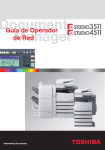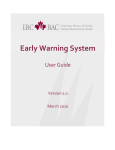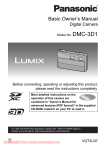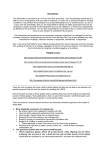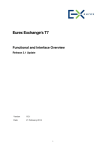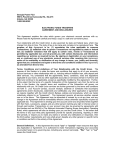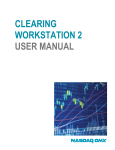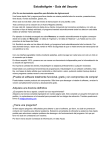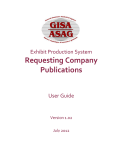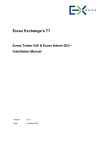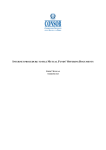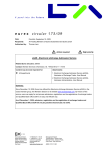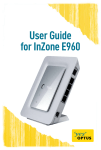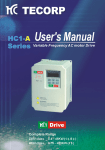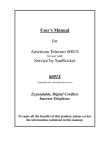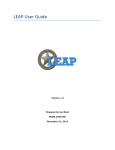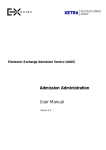Download Quick Reference Guide
Transcript
Quick Reference Guide Client clearing: segregation, porting and collateral management Version 2, December 2014 Contents 1 Introduction ........................................................................................................................ 3 2 Clearing models introduction ............................................................................................. 3 3 Definitions of clients ........................................................................................................... 4 4 Omnibus segregated accounts (OSAs) ............................................................................... 5 OSA by Value .......................................................................................................................... 6 OSA by Asset........................................................................................................................... 6 OSA under CASS ..................................................................................................................... 7 Multiple OSAs ......................................................................................................................... 7 Porting Under Omnibus Models ............................................................................................ 7 5 Individually Segregated Accounts (ISAs) ............................................................................ 8 Porting under the ISA ............................................................................................................. 8 6 Overview of clearing model and client type by market ..................................................... 9 7 Fund Manager Set-Up......................................................................................................... 9 8 Margin Calls ...................................................................................................................... 10 Intraday Margin Calls ........................................................................................................... 10 End of Day Margin Calls ....................................................................................................... 10 Margin calls for the ICM Fund Manager Set-Up .................................................................. 11 Intraday margin calls - OTC IRS business only ...................................................................... 11 9 Cross product margining and account set up ................................................................... 11 10 Asset Tagging - Clearstream sub account options ........................................................ 12 11 Margin assets ................................................................................................................ 12 Collateral allocation for omnibus models ............................................................................ 12 Collateral allocation for ISAs ................................................................................................ 13 Direct delivery for ISA clients ............................................................................................... 13 Withdrawal of collateral....................................................................................................... 14 Handling of excess collateral (auto repay of excess) ........................................................... 14 Permanent cash balance (PCB) ............................................................................................ 14 Collateral cut-off times......................................................................................................... 14 12 Eligible margin assets .................................................................................................... 15 Admissible collateral and haircuts ....................................................................................... 15 Changes to admissible collateral .......................................................................................... 15 Concentration limits ............................................................................................................. 16 Re-investment policy ............................................................................................................ 16 13 Simulation ..................................................................................................................... 16 Dates and batch-runs ........................................................................................................... 17 Margin call ............................................................................................................................ 17 Reports ................................................................................................................................. 17 Position prices ...................................................................................................................... 17 Production and simulation data ........................................................................................... 17 Live simulation for new clients............................................................................................. 17 Simulation margin logic ........................................................................................................ 17 14 Onboarding ................................................................................................................... 18 Onboarding clients to the ECM ............................................................................................ 18 ECM asset based allocation method .................................................................................... 18 Net Omnibus Clearing Model ............................................................................................... 19 Individual Clearing Model .................................................................................................... 19 Onboarding with the Fund Manger Set-up .......................................................................... 20 15 Clearing Model Change ................................................................................................. 20 16 Fees and Costs .............................................................................................................. 21 17 Further information and contacts ................................................................................ 21 18 List of abbreviations ...................................................................................................... 23 2|Page 1 Introduction Eurex Clearing has developed omnibus and individual segregation models to satisfy client, market and regulatory demands. This quick reference guide to client clearing aims to provide clients with an easy to use resource explaining the range of client clearing options, functionality and processes available at Eurex Clearing. Whilst this guide aims to concisely answer the most frequently asked questions, it does not purport to be a fully comprehensive manual. Some chapters contain greater detail then others and, in certain instances, further information and/or contact points at Eurex Clearing is provided. 2 Clearing models introduction All segregation models at Eurex Clearing satisfy the segregation and porting requirements contained within the European Market Infrastructure Regulation (EMIR – properly titled the Regulation (EU) No 648/2012 of the European Parliament and of the Council of 4 July 2012 on OTC derivatives, central counterparties (CCPs) and trade repositories (TRs)). Eurex Clearing offers both OSAs and ISAs. For simplicity’s sake this document uses market standard terminology for all segregation models. It is important to note that Eurex Clearing’s rules and regulations use different naming conventions. Market Standard Terminology Eurex Clearing naming conventions OSA by Value Elementary Clearing Model (ECM) by Value Allocation Method OSA by Asset Elementary Clearing Model (ECM) by Asset Allocation Method OSA under CASS Net Omnibus Clearing Model (NOCM) Multiple OSA Multiple Omnibus Segregated Accounts (MOSA) ISA Individual Clearing Model (ICM) Eurex Clearing does not charge any fees for the clearing model chosen to either the Clearing Member (CM) or client. The high-level account structure is as follows: 3|Page 3 Definitions of clients The segregation models outlined above are available for different client types, active on all cleared markets at Eurex Clearing. The client types are as follows: Undisclosed clients An undisclosed client is known to the CM, but not disclosed to Eurex Clearing. Rather, clients do not have a direct legal relationship with Eurex Clearing. Clients can use one or multiple executing brokers (EB) and one or multiple Clearing Members. Undisclosed client trades are posted into the agency account(s) (A1-A7 or A9) of their CM. As a result of this, it is possible that their collateral and positions will be co-mingled with the Clearing Members other clients (whose identity is also not known to the client or the CCP). An undisclosed client is not eligible for individual segregation. Disclosed clients Disclosed clients are known to Eurex Clearing. They are required to enter into a legal arrangement with Eurex Clearing which reflects their choice of segregation model. There are two types of disclosed client at Eurex Clearing, Registered Customers (RC) and Non Clearing Members (NCM). Registered Customers 4|Page RCs do not have a clearing license and are not a Eurex Trading Participant. The RC concept was initially introduced with Eurex Clearing’s OTC IRS offering and was later extended to include the Eurex Clearing ETD market. For OTC IRS, clients are required to be a member/ user of an Approved Trade Source, such as MarkitWire, to enter OTC IRS trades. RCs may also be active in listed derivatives but they are not able to execute their own trades. RCs are eligible for all segregation models. RCs are required to have access to the Eurex Clearing Common Report Engine (CRE) and, at the discretion of their CM, Individually segregated RC’s may have access to the Eurex Clearing Graphic User Interfaces (GUIs). Non Clearing Members NCMs are Trading Participants who do not hold a clearing license, but execute their own transactions on the exchange. NCMs must have their own infrastructure to manage positions and back office activities, either directly or by outsourcing this function. A NCM is also required to have a Qualified Back-Office Staff member (QBO). If an NCM is not using individual segregation then they are able to outsource this requirement. NCMs are required to have access to the Eurex Clearing Common Report Engine as well as Eurex trading and clearing systems. 4 Omnibus segregated accounts (OSAs) Proprietary clearing of both positions and collateral is entirely ring-fenced from the CMs client clearing activity, with gross position keeping in all accounts (apart from net position keeping in Market Making accounts). Eurex Clearing calculates net initial margin on each position account and calls the Clearing Member for the aggregate sum of those margin requirements. Eurex Clearing allows NCMs and RCs to maintain their own position accounts in the OSA, but their collateral remains in the commingled omnibus collateral pool. Accordingly, margin is calculated gross per an NCM or RC. Clearing Members may choose between three technical implementations of the OSA: OSA by Value OSA by Asset (multiple omnibus collateral accounts available) OSA under CASS (multiple omnibus collateral accounts available) 5|Page OSA by Value The OSA by Value offers an EMIR-compliant clearing solution that comes with no additional operational complexity to CMs. The collateral provided by the CM is dynamically allocated as ECM proprietary collateral and as ECM client collateral in the Eurex Clearing system. The allocation is based on the margin requirement of each pool and segregated at the level of the Clearing House. The Clearing Member receives an end of day (EOD) report reflecting the EOD margin requirements and the value of collateral segregated for ECM clients. The CD043 report shows this: The OSA by Value based allocation method is the default model of Eurex Clearing. OSA by Asset The OSA by Asset segregates client from proprietary collateral at the clearing house level as well as at the (International) Central Securities Depository ((I)CSD) level. If using securities, the CM must open a (sub) account at Clearstream Banking Frankfurt (CBF), Clearstream Banking Luxembourg (CBL) or SIX SIS which holds collateral for ECM asset based allocation method clients only. Cash collateral will be held in the central bank account of Eurex Clearing but allocated as belonging to the OSA by Asset collateral pool. The Clearing Member receives an end of day (EOD) report reflecting the EOD margin requirements and the value of collateral segregated for OSA clients. The OSA client collateral pool naming convention follows this approach (using the clearing condition’s naming conventions): GCMIDXCLIENTECM, CLIENTE01, CLIENTE02, etc. The CD042 report shows this information for each collateral pool: 6|Page OSA under CASS The OSA under CASS is functionally and operationally the same as the OSA by Asset. From a legal perspective it is different as it allows UK Clearing Members to comply with the Client Assets sourcebook (CASS) of the Financial Conduct Authority. For each OSA under CASS Eurex Clearing provides a client money trust acknowledgement letter. Eurex Clearing can provide certain legal opinions in relation to this model and will provide Clearing Members with a client money trust acknowledgement letter. Multiple OSAs Historically, both omnibus models offered Clearing Members a single collateral pool for all clients (NCMs, RCs and non-disclosed customers). This meant that if all clients in the OSA by Asset and OSA under CASS had no option but to be commingled in a single collateral pool. In 2014 Eurex Clearing introduced the ability for CMs to maintain Multiple OSAs, allowing a CM and a client to create additional multiple omnibus collateral pools. This allows groups of clients to be segregated (on an omnibus basis) from a CM’s general omnibus pool. Within the OSA by Asset and the OSA under CASS, a Clearing Member may initially set up a maximum of five (5) omnibus collateral pools (allowing a total of 10 omnibus collateral pools). An omnibus collateral pool must consist of: one or several A-accounts; at least two NCMs or two RCs; or any combination of NCMs, RCs and A-accounts. For the case that a Clearing Member has only one RC or one NCM in a clearing model, this NCM or RC may constitute an omnibus collateral pool alone. Additional omnibus collateral pools will be considered. Porting Under Omnibus Models Porting under any OSA structure is possible only if all clients in the same client collateral pool port to a single replacement Clearing Member (Transferee Clearing Member) and Eurex 7|Page Clearing receives this confirmation by the close of the porting period. If a Termination Event has occurred, the porting period runs from the occurrence of the Termination Event until (and including) 13.00 CET on the immediately following business day. For each Multiple OSA it is possible to assign a back up CM, in a default situation operations would contact this back up. For further details please refer to the Information Memorandum Client Asset ProtectionClient porting under the Elementary Clearing Model (ECM) or contact Sales and Relations. 5 Individually Segregated Accounts (ISAs) The ISA offers full physical segregation of a disclosed client’s positions and collateral. NCM and RC positions are held in segregated position accounts at the CCP level. The margin requirement of an NCM/RC is covered by a dedicated collateral pool at Eurex Clearing, which only holds collateral for the purpose of this NCM/RC. The model was launched in 2011 and since then, Eurex Clearing has made significant investments to enhance the collateral management aspects of the service, for example by introducing asset tagging and direct transfer of collateral. Eurex Clearing will continue to enhance the ISA collateral management functions to increase operational efficiencies. The ISA model is based on a different legal construct to Eurex Clearing’s omnibus models, where collateral is held on a pledge basis. Under the ICM, collateral is passed to Eurex Clearing on a double title transfer basis, meaning Eurex Clearing becomes the legal owner (but the beneficial ownership stays with the collateral provider) with the securities held at Clearstream on behalf of the client. As a results of this, in a default situation, Eurex Clearing may deal with the client directly without the involvement of the CM’s insolvency practitioner. Porting under the ISA When a back up Clearing Member is available, Eurex Clearing will guarantee to port all of the client’s positions and collateral (if all porting conditions are fulfilled within the required timeframe). For clients that do not have a pre-existing relationship with a second Clearing Member, or for clients that require more time, Eurex Clearing offers “interim participation” (IP), allowing the client a period of five business days in which to find a new Clearing Member. This period may be extended with the agreement of Eurex Clearing. For more information regarding the IP process please see the Information Memorandum for Interim Participation. 8|Page 6 Overview of clearing model and client type by market Market standard naming conventions Naming conventions as is Clearing Conditions Client type Eurex Eurex Bonds Eurex Repo Frankfurt Stock Exchange (FWB) Irish Stock OTC Exchange IRS (ISE) OSA by Asset * ECM* Undisclosed ✓ ✓ ✓ ✓ ✓ ✓ -✓ ✓ ✓ -✓ -----✓ ✓ -✓ -----✓ ✓ -✓ -----✓ ✓ -✓ -----✓ RC NCM OSA under CASS* NOCM* Undisclosed RC NCM ISA ICM Undisclosed RC NCM ✓ ✓ -✓ ✓ --✓ -- *Multiple OSAs available (multiple omnibus collateral accounts) 7 Fund Manager Set-Up Eurex Clearing has developed a specific approach to facilitate the onboarding of fund managers. The Fund Manager Set-Up allows the asset management company to sign on behalf of an unlimited number of funds (when the funds have no legal personality or subfunds). This approach results in documentation efficiencies and reporting benefits. In this approach the fund manager becomes a technical RC but each fund remains the legal counterparty, essentially each fund has it’s own ISA . Historically the Fund Manager Set-Up was only available under an ISA structure. Since September 2014 it has been available under OSA structures as well. 9|Page 8 Margin Calls Margin calls are always called against the CM, however margin calls arising from shortfalls on client accounts are calculated and instructed separately, with auto allocation of the cash collateral to the client collateral pool by Eurex Clearing. For cash collateral under all Clearing Models, the CM’s existing payment infrastructure may be used (central bank accounts for EUR and CHF; commercial bank accounts for USD and GBP). All Clearing Members should have access to a USD account for late margin calls. Intraday Margin Calls If there is a margin shortfall on a client account under a CM, Eurex Clearing will issue and process individual margin calls for the collateral pool in which the margin shortfall has occurred. Once an intraday margin call has been issued the CM has 30 minutes to: Enter risk reducing trades; Instruct Eurex Clearing to process a direct debit in any eligible currency considering cut off times against the segregated pool; Deliver security collateral to the collateral pool in shortfall; or In case of a margin shortfall on a segregated pool, transfer cash from its standard pool to segregated pools on a book entry basis. If no action is taken within the 30 minutes then Eurex Clearing will automatically instruct a debit against the Clearing Member’s cash account. If the margin shortfall is a result of a shortfall from a client account, then the cash will be automatically allocated to the segregated pool in which the shortfall occurred by Eurex Clearing. CHF EUR – EUROSIC GBP EUR – TARGET2 USD Intraday margin calls – Cash cut off times (CET) 14:00 15:00 16:30 17:30 22:30 End of Day Margin Calls In case of a margin shortfall on a segregated client account under the CM, Eurex Clearing will issue and process (via auto debit) individual margin calls for the specific collateral pool in which the margin shortfall occurred. The cash will be directly allocated to the collateral pool where the shortfall occurred. Optional ‘payment netting‘ for credits and debits in same currency will be available, please contact Sales and Relations for more information. 10 | P a g e Optional auto-repay of excess cash collateral will be available for ISA segregated pools. For the Fund Manager Set-Up, auto-repay is available at master pool level i.e. the technical RC level1. Please see the following chapter for more information on the master pool logic. Margin calls for the ICM Fund Manager Set-Up1 In order to reduce the total number of intraday margin calls and payment instructions, Eurex Clearing introduced a special process for segregated pools under the ICM Fund Manager Set-Up. One technical “master collateral pool” (master pool) will be set up and linked to each fund manager (technical RC). In case of a margin shortfall on one or more of the ICM Fund Manager Set-Up segregated pools, one margin call will be issued against the technical RC (i.e. Fund Manager) for the aggregated shortfall amount across all individual pools under this RC. The available collateral on the master pool will be allocated dynamically by Eurex Clearing to each individual fund and their collateral pool on a real time basis. A shortfall in one ICM Fund Manager Set-Up segregated pool will never be netted against surpluses in other ICM Fund Manager Set-Up segregated pools. Eurex Clearing only aggregate shortfalls across all pools under a RC. Intraday margin calls - OTC IRS business only In addition to the aforementioned intraday and end of day margining processes, Eurex Clearing has an intraday margin call specifically for OTC IRS business. If insufficient collateral is available to novate new OTC IRS trades a 'Preliminary OTC Margin Call Report' is produced three times a day (12:00, 14:00 and 18:00 CET). This call is mandatory. If the overall risk is not reduced, nor additional collateral provided within 60 minutes, an auto debit will be instructed against the CM. Auto debits are instructed at 13:00, 15:00 and 19:00 CET. If the margin shortfall originated from a client account then Eurex Clearing will automatically allocated the collateral to the collateral pool from which the shortfall originated. For any OTC IRS trades that were submitted for novation before 22.00 CET and could not be novated due to insufficient collateral, an end of day OTC IRS margin call will be issued and settled against the pool in which the shortfall has occurred. 9 Cross product margining and account set up Eurex Clearing Prisma, our portfolio based margin approach, will gradually replace the current margin methodology (Risk-based Margining). It will offer selected cross product and asset class margining for ETD and OTC products cleared at Eurex Clearing. Please see the website for further details. 1 As of OTC IRS release 4.1, end of day margin calls will be issued at ICM Fund Manager Set-Up segregated pool level and cash collateral will automatically be allocated to ICM Fund Manager Set-Up segregated pools. As of November 2014, intraday margin calls will be issued at master pool level but cash collateral from intraday margin calls will automatically be allocated to the ICM Fund Manager Set-Up segregated pools. 11 | P a g e Clients' positions have to be held in the same margin account under the same member ID in order to benefit from cross-margining. For example, an ISA client has to be individually segregated on all markets under the same member ID mnemonic with the same CM to benefit from cross margining. If the client has different relationships in the different markets, i.e. falls under the standard OSA for listed derivatives but is an ISA for interest rate swaps then they would not benefit from cross margining. 10 Asset Tagging - Clearstream sub account options If Clearing Members wish to post securities to Eurex Clearing and have chosen the standard OSA, CASS OSA or ISA then they are required to open a sub account at the CSD. For the ISA, Clearing Members may choose if they wish to have one sub account at CBF/CBFInt 6 Series for each ISA client or one sub account for multiple ISA clients. Where the latter is chosen, asset tagging is implemented at the CSD level. The legal model and protection remains exactly the same for assets held under either model. For asset tagging, the CM has to apply the predefined 4 digit ‘Client Reference ID’ to the SWIFT message (field “RECU/DECU” SWIFT Field 95Q/ 97A; reference number is shown in 97A). Based on this information Eurex Clearing allocates security collateral to the respective collateral pools at Eurex Clearing. Asset tagging is also available for multiple omnibus collateral pools under the Standard OSA and/or CASS OSA. The predefined 4 digit reference entered into the swift message will be the last four characters of the pool, i.e. TECM, TE01 or TNET, TN01. If members are using both OSA models then they must have a minimum of one sub account per a model for asset tagging. Asset tagging is currently only available on CBF/CBF-Int 6 series accounts. 11 Margin assets Collateral allocation for omnibus models Under the OSA by Value Eurex Clearing automatically allocates collateral value pro rata to the clients based on the margin requirement; margin allocation is displayed in the CD043 report. Securities collateral held within all other omnibus models are held in pledge accounts in favor of Eurex Clearing but under the account structure of the CM. The CM delivers security collateral into this (sub) account via swift message. For allocation of cash the CM advises Eurex Clearing via the Eurex@X-tract Clearing GUI (Collateral Transaction Entry window) of the cash deposit. They must specify the collateral pool, currency and amount. Eurex Clearing auto debits the CM’s cash account and allocates the cash automatically to the respective client collateral pool at Eurex Clearing in near-time. 12 | P a g e Alternatively, cash collateral can be allocated to client collateral pools via book only transfer. Collateral allocation for ISAs Where security collateral is delivered to Eurex Clearing by way of double title transfer, the CM instructs the delivery of securities from their main account at CBF/CBF-Int 6 Series to the Eurex Clearing account for the ISA segregated NCMs/RCs using a MT54x SWIFT message to CBF/CBF-Int 6 Series. Upon settlement, the transfer is automatically confirmed by CBF/CBF-Int 6 Series via a SWIFT message, which is sent to both the CM and Eurex Clearing. The confirmation also includes the Client Reference ID for the respective ISA segregated NCM/RC (where asset tagging has been used, see relevant chapter). This allows CMs to automate the booking of collateral in their internal systems for record keeping purposes. For allocation of cash the CM advises Eurex Clearing via the Eurex@X-tract Clearing GUI (Collateral Transaction Entry window) of the cash deposit. They must specify the collateral pool, currency and amount. Eurex Clearing debits the CM’s cash account and allocates the cash automatically to the respective client collateral pool at Eurex Clearing in near-time. Alternatively, cash collateral can be allocated to client collateral pools via book only transfer. To request a template file for book only transfers please contact Sales and Relations. Direct delivery for ISA clients ISA clients may deliver securities collateral from their source account at CBF/CBF-Int 6 series account to the dedicated Eurex Clearing collateral pool at Clearstream via a free of payment (FOP) MT54x SWIFT instruction. For asset tagging, an ISA segregated NCM/RC must apply the respective Client Reference ID to each settlement instruction SWIFT filed 95Q/97A in order for Eurex Clearing to allocate the securities accordingly. Upon settlement CM and Eurex Clearing will receive a SWIFT settlement confirmation from Clearstream to update books and records. Where the delivered securities are not eligible as per Eurex Clearing‘s Eligibility Matrix, Eurex Clearing will return those to the NCM’s/RC‘s source account. For cash, the CM advises Eurex Clearing via the Eurex@X-tract Clearing GUI (Collateral Transaction Entry window) of the NCM’s/RC’s intraday cash deposit by specifying the collateral pool, currency and amount. Eurex Clearing debits the NCM’s/RC’s source account at the respective payment system/correspondence bank and credits the respective amount to the account at Eurex Clearing. Upon receipt of cash collateral on Eurex Clearing‘s account, the collateral balance for the respective ISA segregated NCM/RC collateral pool will be updated in Eurex Clearing‘s systems near-time. 13 | P a g e Withdrawal of collateral All cash and security collateral withdrawals must be requested by the CM via the Eurex@Xtract Clearing GUI (Collateral Transaction Entry window). If the request would not result in a shortfall: Eurex Clearing will return the cash/securities to the CM’s main account at; the CM must then return the cash/securities to the client as required for direct collateral transfer under the ICM, Eurex Clearing will return the cash/securities to the ISA segregated NCM’s/RC’s source account at Clearstream Handling of excess collateral (auto repay of excess) 2 Auto-repay of excess cash collateral at segregated pool level is available. If auto-repay is switched on then all excess cash will be automatically credited back to the Clearing Members main account in the morning as part of the end of day process. If not selected, then all excess collateral will stay at the segregated pool until a withdrawal is requested. For the fund manager set up auto repay is available at the master pool level. Excess Variation Margin is always automatically returned to the Clearing Member’s cash account after any potential offsets against Initial Margin shortfalls. Permanent cash balance (PCB) Clients have the option to set a PCB per a segregated pool. PCB is the pre-defined cash amount that a CM or client wants to hold at Eurex Clearing. CMs can maintain the PCB via Eurex @X-tract Clearing GUI Collateral Pool Overview Window. Activation of the PCB might lead to a cash movement in the morning: mandatory cash call if cash balance in the respective collateral pool and currency falls below the predefined PCB - regardless of collateralization level auto-return of excess cash above the predefined PCB in the respective collateral pool in clearing currency - only if no under-collateralization The permanent cash balance functionality is only available for CHF and EUR currencies. Collateral cut-off times Securities: Deposits have to be instructed by 18:00 CET for SIX SIS, 20:00 CET for CBF and CBL Withdrawals have to be instructed by 17:30 CET for CBF and CBL and SIX SIS If an ISIN is to be withdrawn as early as possible on the next business day, this withdrawal can be requested up to 30 minutes past the cut-off time of the current business day (from 18:00 CET onward). 2 With Calypso Release 4.1, the optional auto-repay functionality will be available at ICM Fund Manager Set-Up segregated pool level 14 | P a g e Cash: Please see below an overview of Eurex Clearing’s cut off times for cash collateral (all in CET) Currency Deadlines for same Deadline for cash day cash collateral Deadlines for collateral withdrawal deposit requests same day requests for next day receipt of request excess cash processing (fax only) via: collateral withdrawal Release of Eurex requests via Receipt of cash @X-tract Eurex@X-tract fax* at Eurex collateral by Fax* Clearing Clearing GUI Clearing Eurex GUI Clearing** Deadlines to determine the credit balance for the interest calculation on the collateral pool Target 2 17:00 17:00 09:30 18:00 8:00 15:00 Euro SIC 14:00 13:45 09:30 18:00 8:00 15:00 USD 21:00 20:45 09:30 21:00 8:00 21:00 CHF 13:30 13:15 09:30 18:00 9:00 10:00 GBP 16:30 16:15 09:30 18:00 9:00 10:00 EUR *on behalf service only **upon request 12 Eligible margin assets Admissible collateral and haircuts CMs can satisfy margin and clearing fund requirements by depositing cash and/or security collateral. Eurex Clearing sets the industry standard and accepts over 25,000 ISINs based on liquidity categories of European Central Bank Eligible Asset Database and the Swiss National Bank and accepts cash collateral in multiple currencies. A full list of acceptable securities and haircuts is published (in .txt format) on our website daily http://www.eurexclearing.com/clearing-en/risk-management/risk-parameters/ (admissible securities); the same list is distributed via Common Report Engine in .csv and .txt format. Changes to admissible collateral If a security is no longer accepted at Eurex Clearing (i.e. rating downgrade outside Eurex Clearing's matrix, market movements etc.), Eurex Clearing will call the CM and require a withdrawal or substitution of the securities. The withdrawal or substitution period is dependent on the reasons for ineligibility, and will be confirmed by Eurex Clearing. In case of maturity, Eurex Clearing will inform the Clearing Member six weeks prior to maturity via email/fax. If no action is taken by the Clearing Member, 15 calendar days prior to maturity 100% haircut will be applied. Where the CM does not withdraw or substitute the securities, Eurex Clearing will inform the Clearing Member one day prior to maturity in the morning. If again no action is taken by the Clearing Member by 15:00 CET on that day, the securities in questions would be returned to the CM. 15 | P a g e Concentration limits Eurex Clearing applies concentration limits at two levels, the clearing house level and the Clearing Member level. Limits on the clearing house level are applied across every Clearing Member (including all their clients) at Eurex Clearing. Concentration limits at the member level apply per Clearing Member, this includes the CMs own business and the business of their OSA clients. Individually segregated customers are treated as a separate entity and the same limits that apply to their Clearing Member apply to them. On a clearing house level: • • For bonds, the admissible proportion of the issued capital is 25% For equities, the admissible proportion of free float is 5% On a Clearing Member/ISA level: • A maximum of 30% of the required collateral can be deposited in equities (so a CM may post 30% securities and their individually segregated client could post 30%). There are no multipliers or additional haircuts to be levied should these limits be breached. On the clearing house level collateral is accepted until the capacity of an ISIN is reached. Members may check limits via the GUI. If limits are breached on a Clearing Member level a notification is sent out to the CM to immediately amend the composition of its collateral. If it is the ISA client that has breached the concentration limits, Eurex Clearing will not contact them directly but contact their CM. Re-investment policy Cash investment only takes place at counterparts with high creditworthiness. Key criteria of Eurex Clearing treasury policy are: Secured placement to the extent possible (reverse repo and tripartite repo are the preferred instruments) Minimum counterparty rating of AMinimum security rating of AAIssuer must be government, agency or supranational Placement tenor restricted; majority to be invested with a tenor of one business day (small percentage can be invested up to one month) 13 Simulation This section contains general information about simulation as well as simulation for client asset protection services. 16 | P a g e Dates and batch-runs In general Eurex Clearing performs two to three batch-runs a week in simulation. Accordingly, a trade date covers more than one actual day. For specific details, please refer to the current simulation calendar: For listed derivatives http://www.eurexchange.com/exchange-en/technology/simulation-calendar/ For OTC IRS please visit the member section Member Section > Clearing Resources > Simulation > EurexOTC Clear Simulation For CCP clearing please visit the member section www.eurexclearing.com > Member Section > Simulation > CCP Standard Simulation Margin call Margin calls and requirements are calculated using the same methodology but parameters and prices may differ. Reports Simulation reports are available as they are for production (excluding some fee reports). Reports are available in XML-format and some reports are provided in a readable text format as well. Please see our website for the comprehensive technical Eurex Clearing Reporting Manual. OTC IRS customers may also wish to review the OTC IRS report manual. Position prices For futures the previous day's production settlement prices will be provided in the simulation environment; for options the settlement prices are based on simulation volatility. Production and simulation data Whilst it is possible to have separate test environments for all markets, it is not possible to cover all product types per market. Therefore a complete upload of production data into the simulation environment is not possible. Live simulation for new clients New NCMs, RCs and fund managers take approximately five days to set up in simulation. Please contact Trading & Clearing Services for further details. Simulation margin logic Eurex Clearing is currently in the process of migrating from Risk-Based Margining towards Value at Risk based Prisma. Please see the Prisma release timelines on the website for further details. 17 | P a g e Eurex Clearing provides, besides the standard margin reports, an additional set of margin reports under the assumption that a Clearing Member migrates all positions and Liquidation Groups which are already available under the new margin methodology to Eurex Clearing Prisma. The reports produced are marked separately, i.e. report numbers contained in the report names start with the digit 9. 14 Onboarding For a detailed list of required forms and agreements, necessary for the various clearing models and customer types, please contact your Key Account Manager. In general all forms and agreements are also available on www.eurexclearing.com > Resources > Forms. As all the forms and documentation use the naming conventions consistent with the clearing conditions, this chapter does not use market standard terminology, please see chapter “Naming Conventions in the Clearing Conditions” for a comparison table. Onboarding clients to the ECM CM adopting ECM value based allocation method To onboard NCMs and RCs, each party has to enter into the tripartite agreement titled: “Clearing Agreement with a Non-Clearing Member and/or Registered Customer for the Elementary Clearing Model” (Appendix 2 to the Clearing Conditions). Where a CM and client enter into this documentation with Eurex Clearing, no further documentation is required, but if the CM and client entered into an additional agreement, in the event of any inconsistencies, the tripartite agreement would always prevail (see Clearing Conditions Chapter I, Part 3, Number 2.1.4). The client has no recourse to Eurex Clearing for positions and collateral in the event of their Clearing Member default (as they would have in the ICM). There are no documentation requirements for a non-disclosed client entering into the ECM value based allocation method. ECM asset based allocation method CM adopting ECM asset based allocation method When a CM switches from the default ECM value based allocation method to the ECM asset based allocation method (OSA by asset), the CM has to sign a new clearing agreement electing to use the ECM asset based allocation method. The relevant section is Part 3, Number 2 of the Elementary Standard Agreement. The CM has to also complete and submit the "Application for Elementary Clearing Model Asset Based Bulk Upload Sheet" (available on https://member.eurexclearing.com > Risk & Collateral Management > Client Asset Protection > Admission Forms > Elementary Clearing Model - Asset Based) 18 | P a g e If the Clearing Member would like to provide non-cash collateral, a Clearstream (sub-) account has to be opened by the Clearing Member. For more details on this, please liaise directly with your Clearstream Account Manager. All NCMs and RCs are automatically assigned to the ECM model (be it the value or asset based allocation method) that their Clearing Member has chosen. The NCM or RC may elect to change models (either to the NOCM or the ICM) by signing the relevant documentation. Net Omnibus Clearing Model The NOCM (OSA under CASS) operates from a documentation perspective as the ECM asset based allocation method. The relevant forms are set out below. If a CM would like to start to offer the Net Omnibus Clearing Model he needs to sign a new Clearing Agreement and must select point 3.1 that states “This Agreement also qualifies as a Net Omnibus Clearing Agreement for Customer-Related Transactions” in Part 3 of the Clearing Agreement. If an NCM/RC would like to onboard to the Net Omnibus Clearing Model they must sign the tripartite agreement “Clearing Agreement with a Net Omnibus Non-Clearing Member and/or Net Omnibus Registered Customer for the Net Omnibus Clearing Model” (Appendix 8 to the Clearing Conditions) with their Clearing Member. NCMs/RCs who are already admitted with the Elementary Clearing Model (value based allocation method/ asset based allocation method) or Individual Clearing Model need also to sign the Agreement “Change of Clearing Model” with their CM. If the Clearing Member would like to provide non-cash collateral, a Clearstream (sub-) account has to be opened by the Clearing Member. For more details on this, please liaise directly with your Clearstream Account Manager. Please note: For detailed information NCMs/RCs should contact their Key Account Manager There are no documentation requirements for a non-disclosed client entering into the NOCM. Individual Clearing Model If a NCM/RC would like to switch into the Individual Clearing Model, they must sign the tripartite agreement “Clearing Agreement for the Individual Clearing Model under Eurex Clearing AG Documentation” or “Agreement for the participation in the Individual Clearing Model under Client Clearing Documentation” with their Clearing Member. The second option allows Clearing Members and clients to agree to use the market standard client clearing documentation such as the ISDA/FOA OTC Client Clearing Addendum, the FOA Client Cleating Module or the German Banking Associations CRV. 19 | P a g e If the Clearing Member would like to offer “the Individual Clearing Model under Client Clearin g Documentation “ they need to additionally provide a CM Agreement with the election under section 4 “ICM Clearing Agreement for ICM-CCD”. NCMs/RCs already under the Elementary Clearing Model (value based allocation method/ asset based allocation method) or Net Omnibus Clearing Model moving to the ICM need to also sign the Agreement “Change of Clearing Model” with their CM. In addition to this the "Application for Individual Clearing Model Bulk Upload Sheet" (available on https://member.eurexclearing.com > Risk & Collateral Management > Client Asset Protection > Admission Forms > Individual Clearing Model) has to completed and submitted by the Clearing Member If a client and CM would like to provide non-cash collateral, a Clearstream (sub-) account has to be opened by the Clearing Member. For more details on this, please liaise directly with your Clearstream Account Manager. . In addition to the information contained in this section you may also wish to see the information memoranda set out below: Information Memorandum Client Asset Protection Setup for individual Segregation Information Memorandum Admission as Registered Customer at Eurex Clearing Please note: For detailed information a disclosed client should contact its Key Account Manager or Sales and Relations. Onboarding with the Fund Manger Set-up In case a client decides to on-board with the Fund Manager Set-Up, the "Upload Sheet Flex Accounts" (available on https://member.eurexclearing.com > Risk & Collateral Management > Client Asset Protection > Admission Forms > Flexible Accounts) has to be signed by both the CM and the client as an annex to the tripartite clearing agreement.. It serves to compile a list of the funds that should be organised within the flexible account. Depending on the choice of clearing model, different information is required in order to complete the setup. Both the CM and the Registered Customer need to sign off the sheet, before it can be accepted by Eurex Clearing. Please note that all funds will be subject to Eurex Clearing's KYC check and fund managers might have to provide additional information and documents, such as prospectuses, in the course of the admission process. Please contact your Key Account Manager for further details. 15 Clearing Model Change Eurex Clearing has developed a position and migration guide to assist CMs, please contact us for a copy. Position transfers can be processed in agreement with Eurex Clearing on any business day. CMs may opt to transfer listed derivative positions themselves through the GUI or can arrange a file upload through the clearing helpdesk. Please note, when Eurex Clearing 20 | P a g e conducts a position transfer on behalf of a CM within a clearing model, a charge of EUR 1,000 is applied. This charge is not applied when the position transfer occurs between different clearing models (e.g. ECM to ICM). CMs are advised to check with their CSD regarding any fees they may charge for transferring securities collateral between accounts. Eurex Clearing will support and facilitate position transfers in conjunction with Clearing Members. 16 Fees and Costs Eurex Clearing does not charge for use of segregation models. Securities collateral used to cover margin requirements are subject to a management charge of 5 basis points. Any over-collateralization is not charged. The securities collateral management charge is not applicable to IRS business of Registered Customers. 17 Further information and contacts Further information can be found at: http://www.eurexclearing.com/clearing-en/risk-management/client-asset-protection/ In particular Clearing Members may be interested in the resource section of the website for simulation and production forms: http://www.eurexclearing.com/clearing-en/resources/ The Clearing Conditions can be accessed at: https://www.eurexclearing.com/clearing-en/resources/rules-and-regulations/136778/ The OTC IRS onboarding guide: http://www.eurexclearing.com/blob/clearing-en/5149651498/743724/3/data/eurexotc_clear_onboarding_guide.pdf The OTC IRS procedures manual: http://www.eurexclearing.com/blob/clearing-en/141430158180/185330/5/data/eurexotc_clear_irs_procedures_manual.pdf The Eurex XML reporting manual: http://www.eurexchange.com/blob/exchange-en/156096176058/790330/1/data/Eurex_T7_Report_Reference_Manual_V204.pdf The Eurex User Manual - System Overview & Information Manual: http://www.eurexclearing.com/clearing-en/technology/eurex-release-14/systemdocumentation/ 21 | P a g e Eurex Clearing Sales & Relations and Business Development For general sales enquiries please contact: Byron Baldwin T: +44 (0)20 786 27266 M: +44 (0)7884 655089 [email protected] For Client Asset Protection & Business Development enquires please contact Richard Wilding Deputy Head of Business Development T +44 (0)20 7862 7279 M +44 (0)7824 142703 [email protected] Clearing Helpdesk Queries about collateral management, exercise & assignment and notification & allocation +49-69-211-1 12 50 [email protected] Open 07:00 –22:30 CET Risk Hotline Queries about margining and risk reports T +49-69-211-1 24 52 [email protected] Open 08:00 – 22.30 CET Trading & Clearing Services Every Clearing Member is assigned a key account manager, who form the trading and clearing services team; please contact them directly with any queries: Frankfurt Tel+49-69-211-117 00 [email protected] Zurich +41 58 854 2942 [email protected] London +44 20 7862 7299 [email protected] 22 | P a g e Paris +33 155 276 767 [email protected] Chicago +1 312 544 1150 [email protected] Onboarding Team for EurexOTC IRS Service [email protected] 18 List of abbreviations (I)CSD CAP CASS CBF CBL CCP CCY CHF CM ECM EMIR EOD EUR FAS FOP GBP ICM IRS ISA ISIN KAM MR NCM NOCM OSA OTC RC SIX SIS TKAM USD International central securities depository Client Asset Protection Client Assets sourcebook Clearstream Banking Frankfurt Clearstream Banking S.A. (Luxembourg) Central counterparty Clearing Currency Swiss Franc Clearing Member Elementary Clearing Model Regulation (EU) No 648/2012 of the European Parliament and of the Council of 4 July 2012 on OTC derivatives, central counterparties (CCPs) and trade repositories (TRs) commonly referred to as the European Market Infrastructure Regulation End of day Euro Flexible Account Structure Free of Payment Great British Pound Individual Clearing Model Interest rate swap Individual segregated account International Securities Identification Number Key Account Manager Margin Requirement Non-Clearing Member Net Omnibus Clearing Model Omnibus segregated account Over-the-counter Registered Customer National Central Securities Depository (CSD) of the Swiss financial market Technical Key Account Manager United States Dollar 23 | P a g e























